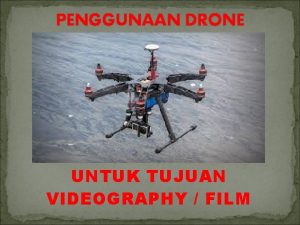Control of UAV Teams Michael Lewis University of

- Slides: 1

Control of UAV Teams Michael Lewis University of Pittsburgh Paul Scerri & Katia Sycara Carnegie Mellon University LOCAAS & wide area search munitions P-LOCAAS Flight Test Coordinating UAV Teams There are two general classes of robotic coordination, swarms and intentional Swarms have lar appearing group behavior, but they are incapable of complex coordination involving roles with Turbojet 40” Ladar Machinetta Pre-condition Machinetta provides an infrastructure for coordination. Machinetta proxies come with mechanisms for task allocation, commitment and decommitment to plans and other joint activities needed for coordination. Using Machinetta proxies teams of UAVs can behave in an intentional manner to achieve their controller’s objectives 30” Wide Area Search Munitions (WASMs) are a cross between an unmanned aerial vehicle and a munition. The first of these high concept munitions, the Low Cost Autonomous Attack System (LOCAAS), is envisioned as a miniature, autonomous powered munition capable of broad area search, identification, and destruction of a range of mobile ground targets. Falcon. View-based Interface The Falcon. View interface will be used to launch and direct a live PLOCAAS prototype that will fly a mission with three simulated teammates. Coordination among munitions could allow WASMs to perform battle damage assessment for one another, stage simultaneous attacks on a target, and perform other coordinated activities that could multiply the effectiveness of such munitions. AC-130 Flank Support test FLIR/Coordinates AC-130 Simulator Acknowledgements This project is supported by AFRL/MN and involves the contributions of many others including Rob Murphy and Kevin O’Neal from AFRL, Rolan Tapia and Doug Zimmerer of Lockheed-Martin, and Paul Arezina from the University of Pittsburgh OTB Post-condition WASM Before AND Role WASM Target X destroyed Terminate Plan I see a Target at Y Designtime Layers of control Pre-launch/programming • Mission planning • Reactive behaviors agent level • Team oriented plans In flight Parameter tuning: highly nonlinear/unpredictable –Reactive behaviors (aggressiveness) 3 D Database –Team plan parameters Direct command: Video – Alert Message 1 WASM Simulator Operator Display 3 D Database An experimental user interface for controlling WASMs was constructed by adding a toolbar to the Falcon. View personal flight planning system, a popular flight planning system used by military pilots. The user controls individual or teams of WASMs by sketching ingress paths, search or jettison regions and other spatially meaningful instructions. WAS M dispen se Finding the levers We need someone for a BDA role! Fire Control, Redirect and Supervisor PDUs – TAI Encountered – ID Target – Interactive Display – Specify TAI – Fire Authority Entity State, Object State, and Weapon State PDUs • Teleop • Goals: waypoints, regions, & ROE Plan-based interaction –Instantiate team oriented plans DREN –Fill role in team oriented plans An initial evaluation of the Falcon. View tasking interface was conducted for WASM conops for flank patrol for an AC-130 aircraft supporting special operations forces on the ground. In the test scenarios the WASMs were launched as the AC-130 entered the battlespace. Three scenarios, one training and two with active data collection were flown in an AC-130 simulator by instructors at the Hurlburt Field SOCOM training facility. Controllers were able to effectively direct the munitions and successfully attack a majority of targets. In order for operators to configure and control teams effectively we are developing methods to create a team performance model to capture the relation between the environment, team configuration parameters and measures of performance. Using the team performance model in reverse allows operators to specify performance tradeoffs and rapidly find a configuration that best meets those constraints. In initial experiments we have demonstrated the ability of an operator to control the global behavior of a large team using a team performance model to guide actions.

